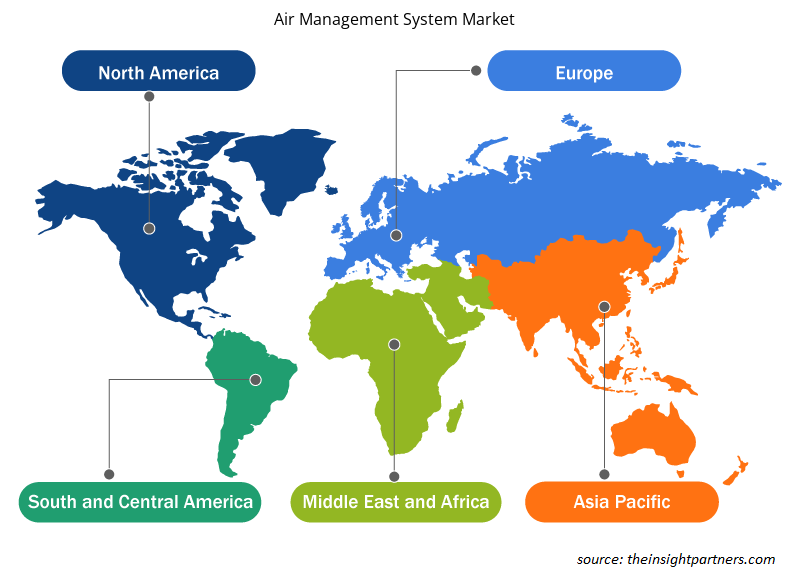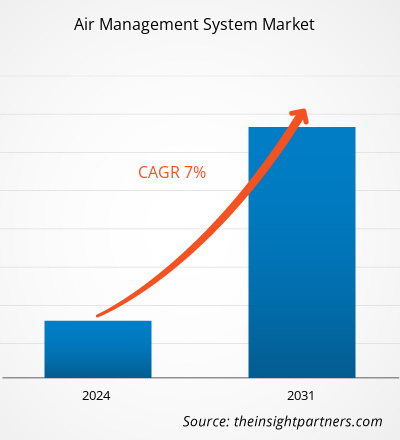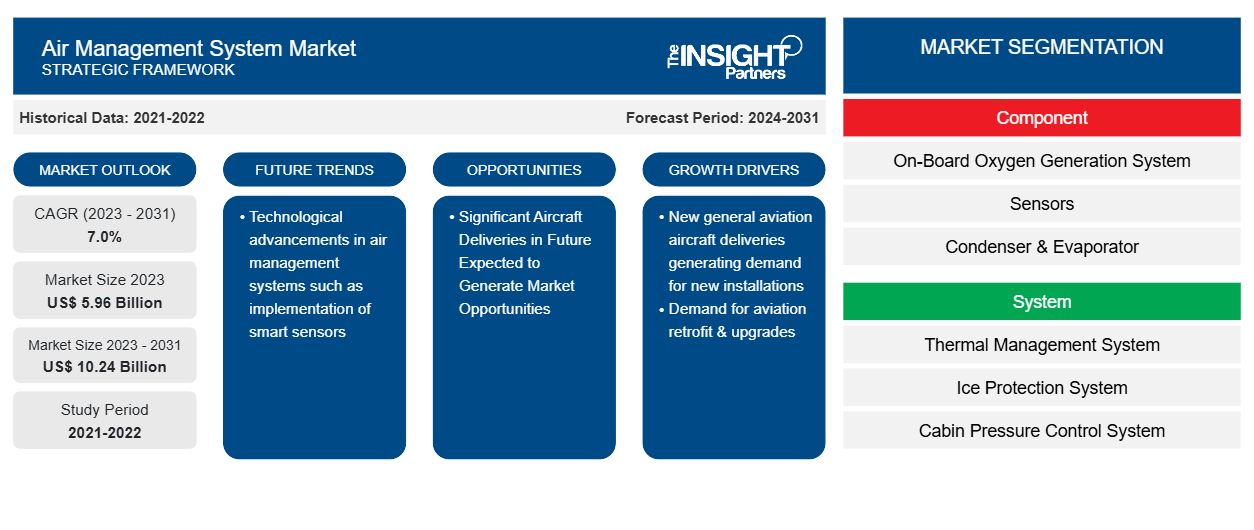空気管理システムの市場規模は、2023年の59億6,000万米ドルから2031年には102億4,000万米ドルに達すると予測されています。市場は2023年から2031年の間に7.0%のCAGRを記録すると予想されています。スマートセンサーの実装など、空気管理システムの技術的進歩は、市場の主要なトレンドであり続けると思われます。
空気管理システム市場分析
空気管理システム市場のエコシステムは多様で進化しています。その利害関係者は、サプライヤー、コンポーネント、航空機メーカー、およびエンドユーザーです。主要プレーヤーは、市場エコシステムのさまざまなノードで地位を占めています。原材料プロバイダーは、コンポーネントメーカーに材料を供給し、それらを使用して最終製品の製造と設計を行います。その後、最終製品は、会社の販売代理店による直接販売やサードパーティの販売代理店によるサードパーティ販売など、さまざまな媒体を通じて航空機メーカーに供給されます。その後、航空機メーカーまたは OEM は、航空機コンポーネントをそれぞれの航空機モデルに統合します。
空気管理システム市場の概要
空気管理システム市場は、いくつかの定評ある企業で構成されており、上位 5 社のベンダーが約 25% のシェアを獲得し、エンド ユーザーからそれぞれの製品を定期的に調達しています。空気管理システム市場のプレーヤーは、テクノロジー、リード タイム、価格など、さまざまなパラメーターで互いに競争しています。これらのパラメーターは、市場プレーヤー間の競争力を高め、空気管理システム市場のプレーヤー間で高いレベルの競争を維持することが期待されています。
要件に合わせてレポートをカスタマイズする
このレポートの一部、国レベルの分析、Excelデータパックなど、あらゆるレポートを無料でカスタマイズできます。また、スタートアップや大学向けのお得なオファーや割引もご利用いただけます。
-
このレポートの主要な市場動向を入手してください。この無料サンプルには、市場動向から見積もりや予測に至るまでのデータ分析が含まれます。
空気管理システム市場の推進要因と機会
航空機の改修とアップグレードの需要
世界中に多数の旧式の商用航空機フリートが存在することで、既存フリートの改修やアップグレードの需要が生まれています。また、新しい航空機MRO格納庫やMROベイの立ち上げは、さまざまな空気管理システムの需要に正比例しており、空気管理システム市場の強力な触媒の1つです。さらに、既存の航空機フリートの拡大に伴う航空機のアップグレードへの航空会社の継続的な投資により、空気管理システムの需要が世界的に高まっています。たとえば、インドの航空業界のリーダーの1つであるInterGlobe Aviation Ltd.(インディゴ航空)は、2019年にバンガロール国際空港株式会社(BIAL)と20年契約を締結し、インドで2番目のMRO施設を建設しました。同社の声明によると、新しい格納庫は2機のナローボディ機とエンジンMROに対応できます。
将来的には航空機の大量納入が市場機会の創出につながると期待される
民間航空部門は長年にわたって堅調な航空機群を維持しており、納入統計の点ではエアバスとボーイングが最も注目すべき2つの航空機メーカーです。民間航空業界は、新しい格安航空会社(LCC)の出現とフルサービス航空会社(FSC)による航空機群拡大戦略の採用により、過去数年間で驚異的な成長を遂げてきました。航空旅行の乗客数と航空機調達の増加により、今後数年間で民間航空が急増すると予想されています。さらに、民間航空機と軍用航空機の将来の納入が予想されることは、今後数年間で市場ベンダーに新たな機会を生み出す可能性が高い主要な要因の1つです。たとえば、ボーイングとエアバスの予測によると、2023年から2042年の間に世界中で40,800機以上の民間航空機が納入される可能性があります。
空気管理システム市場レポートのセグメンテーション分析
空気管理システム市場分析の導出に貢献した主要なセグメントは、コンポーネント、システム、およびプラットフォームです。
- コンポーネントに基づいて、空気管理システム市場は、オンボード酸素生成システム、センサー、コンデンサーと蒸発器、空気サイクルマシン、制御および監視電子機器ユニット、その他に分類されます。空気サイクルマシンセグメントは、2023年に大きな市場シェアを占めました。
- システムに基づいて、空気管理システム市場は、熱管理システム、氷保護システム、キャビン圧力制御システム、燃料タンク不活性化システム、酸素システム、およびエンジンブリードエアシステムに分類されます。熱管理システムセグメントは、2023年に大きな市場シェアを占めました。
- プラットフォームに基づいて、空気管理システム市場は固定翼と回転翼に分割されます。固定翼セグメントは2023年に大きな市場シェアを占めました。
地域別空気管理システム市場シェア分析
空気管理システム市場レポートの地理的範囲は、主に北米、ヨーロッパ、アジア太平洋、中東およびアフリカ、南米の 5 つの地域に分かれています。
2023年にはアジア太平洋地域が市場を支配し、北米とヨーロッパ地域がそれに続きます。さらに、アジア太平洋地域は今後数年間で最高のCAGRを記録する可能性もあります。中国はアジア太平洋地域の空気管理システム市場で大きなシェアを占めていますが、インドは今後数年間で世界で最も魅力的な空気管理システム市場の1つになる可能性があります。中国は米国最大の航空市場を上回り、世界で最も急速に成長している航空市場の1つになっています。同国では、今後20年間で航空機の需要が高くなることが予想されています。たとえば、エアバスの予測によると、2023年から2042年の間に9,400機以上の商用航空機が中国に納入される可能性があります。さらに、国内外のメーカーによる航空機生産数の増加により、長期的には、中国と東南アジアがMROセンターとしての重要性を確立するにつれて、航空機のMRO活動はAPAC地域に移行するでしょう。世界中の企業が中国への事業拡大に注力しています。たとえば、サフラン社はMROサービスを中国に拡大し、中国の航空会社にさまざまな部品に関するサービスを提供しています。さらに、中国は米国に次ぐ第2位の防衛費支出国です。中国は防衛力に多額の投資を行っており、空軍は新しい航空機群を調達することができます。それでも、軍事費の増加と航空機の需要により、中国の航空管理システム市場に新たな成長機会が生まれると予想されています。
空気管理システム市場の地域別洞察
予測期間を通じて空気管理システム市場に影響を与える地域的な傾向と要因は、Insight Partners のアナリストによって徹底的に説明されています。このセクションでは、北米、ヨーロッパ、アジア太平洋、中東およびアフリカ、南米および中米にわたる空気管理システム市場のセグメントと地理についても説明します。

- 空気管理システム市場の地域別データを入手
空気管理システム市場レポートの範囲
| レポート属性 | 詳細 |
|---|---|
| 2023年の市場規模 | 59.6億米ドル |
| 2031年までの市場規模 | 102.4億米ドル |
| 世界のCAGR(2023年~2031年) | 7.0% |
| 履歴データ | 2021-2022 |
| 予測期間 | 2024-2031 |
| 対象セグメント |
コンポーネント別
|
| 対象地域と国 |
北米
|
| 市場リーダーと主要企業プロフィール |
|
市場プレーヤーの密度:ビジネスダイナミクスへの影響を理解する
空気管理システム市場は、消費者の嗜好の変化、技術の進歩、製品の利点に対する認識の高まりなどの要因により、エンドユーザーの需要が高まり、急速に成長しています。需要が高まるにつれて、企業は提供を拡大し、消費者のニーズを満たすために革新し、新たなトレンドを活用し、市場の成長をさらに促進しています。
市場プレーヤー密度とは、特定の市場または業界内で活動している企業または会社の分布を指します。これは、特定の市場スペースに、その市場規模または総市場価値に対してどれだけの競合相手 (市場プレーヤー) が存在するかを示します。
空気管理システム市場で事業を展開している主要企業は次のとおりです。
- パーカー・ハネフィン株式会社
- ハネウェルインターナショナル株式会社
- ディール財団
- コリンズエアロスペース
- リープヘル インターナショナル ドイチュランド GmbH
免責事項:上記の企業は、特定の順序でランク付けされていません。

- 空気管理システム市場のトップキープレーヤーの概要を入手
空気管理システム市場のニュースと最近の動向
空気管理システム市場は、主要な企業出版物、協会データ、データベースなどの一次調査と二次調査後の定性的および定量的データを収集することによって評価されます。空気管理システム市場の動向のいくつかを以下に示します。
- AMETEK Singapore PTE は、エアバス A350 のメンテナンス ソリューションに投資することで、その能力を強化しました。この決定により、アジア太平洋地域の顧客に、この航空機タイプ用の貨物およびギャレー ヒーター一式に対する地域サポート オプションが提供されることになります。これは、AMETEK が現在取得している CAAS、CAAC、FAA、EASA、JCAB、CAAM、CAAV、DGCA などの耐空性承認によってさらに補完されることになります。(出典: AMETEK Singapore PTE、プレス リリース、2022 年 1 月)
- ハネウェル(NYSE: HON)は、商用航空機と軍用航空機の両方に適用される次世代のキャビン圧力制御および監視システムを発表しました。このシステムの新バージョンは、全電動で軽量化されており、ビジネスおよび地域航空、戦術または軍用トレーナーサイズの航空機で現在利用可能です。(出典:ハネウェルインターナショナル社、プレスリリース、2021年1月)
空気管理システム市場レポートの対象範囲と成果物
「空気管理システム市場規模と予測(2021〜2031年)」レポートでは、以下の分野をカバーする市場の詳細な分析を提供しています。
- 対象範囲に含まれるすべての主要市場セグメントについて、世界、地域、国レベルでの空気管理システム市場規模と予測
- 空気管理システム市場の動向、および推進要因、制約、主要な機会などの市場動向
- ポーターの5つの力の詳細な分析
- 主要な市場動向、世界および地域の枠組み、主要プレーヤー、規制、最近の市場動向を網羅した空気管理システム市場分析
- 市場集中、ヒートマップ分析、主要プレーヤー、空気管理システム市場の最近の動向を網羅した業界の状況と競争分析
- 詳細な企業プロフィール
- 過去2年間の分析、基準年、CAGRによる予測(7年間)
- PEST分析とSWOT分析
- 市場規模価値/数量 - 世界、地域、国
- 業界と競争環境
- Excel データセット
最新レポート
関連レポート
お客様の声
購入理由
- 情報に基づいた意思決定
- 市場動向の理解
- 競合分析
- 顧客インサイト
- 市場予測
- リスク軽減
- 戦略計画
- 投資の正当性
- 新興市場の特定
- マーケティング戦略の強化
- 業務効率の向上
- 規制動向への対応























 無料サンプルを入手 - 空気管理システム市場
無料サンプルを入手 - 空気管理システム市場